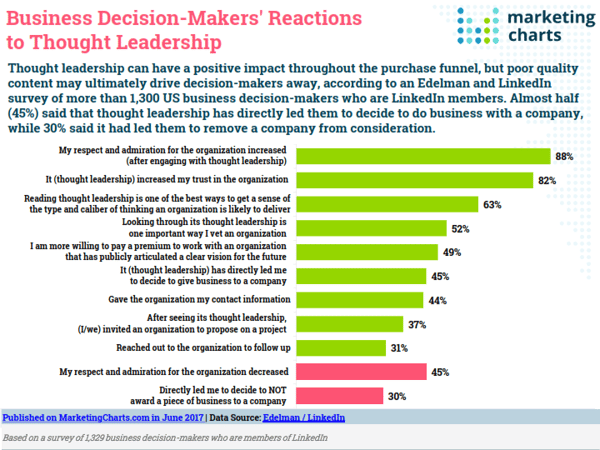 Thought leadership may seem like the buzzword du jour however it is a critical element for establishing trust and credibility with your prospects and customers. According to a recent LinkedIn survey, 45% of decision makers said that thought leadership directly led them to decide to do business with the company while 30% said it led them to remove a company from consideration.
Thought leadership may seem like the buzzword du jour however it is a critical element for establishing trust and credibility with your prospects and customers. According to a recent LinkedIn survey, 45% of decision makers said that thought leadership directly led them to decide to do business with the company while 30% said it led them to remove a company from consideration.
Thought leadership shapes perception of you, your company, and its products. Real thought leadership can be as valuable to a brand as the products or services it sells.
What is a thought leader?
A thought leader is an individual or a firm that has significant influence because of their knowledge in their field of expertise. They are trusted sources who share innovative ideas, turn these ideas into reality, and demonstrate how to replicate their success.
Does this sound easy? It definitely is not.
How to Establish Thought Leadership
The term thought leader is an earned moniker; not automatically bestowed on anyone that claims to be a thought leader. It does not happen with a single speaking opportunity or article placement. It is a process and a collection of work where you create credibility and earn the trust of your audience.

The journey is not always smooth sailing. The world is full of naysayers; thought leaders are definitely targets for contrary opinions. Be ready to take some barbs and defend your position with thoughtful arguments backed up by industry trends and statistics.
Here are nine ways to begin establishing thought leadership.
- Be an expert – To become a thought leader you really need to know your stuff, inside and out. Will you know everything? Of course not but you need to have a body of knowledge to draw on in almost every situation. Take a stand, be humble and vulnerable, and listen to your critics – to a point. Hear what they have to say and decide if you need to pivot your views.
- Talk about the future – People are always speculating about what is going to happen in the future and they love to hear about any prediction that you may have. Twenty years ago, we had a client that was in the forefront of voice technology. To demonstrate the future and power of voice technology he would begin a conversation with, “Someday, you are going to be able to pick up the phone and just say ‘I want a pepperoni pizza.’ In twenty minutes, a pepperoni pizza is going to show up at your door. You voice will activate a number of events. It will find the closest pizza shop, place your order, and know where to deliver it.” He then continued to educate his audience about voice technology on what was viable today and how it would evolve in the next two years, five years, and in ten years.
- Speak at industry events – Begin speaking at industry gatherings – conferences, trade show, and at trade associations. You can speak as part of a panel or secure a solo speaking slot. Start small and gain experience and confidence. Larger events and Ted Talks are looking for experienced speakers and you will likely have to submit a portfolio of speeches before you are granted a coveted slot. Video your speeches and post them on your web site and YouTube. Use social media to amplify your experience throughout the industry.
- Write for a Publication – Bylined articles in a third-party publication are a great way to demonstrate thought leadership and they have more credibility than blog posts on your own website because they are vetted by the publication. This extra level of scrutiny is perceived as more credible. According to Hubspot’s State of Inbound 2017 report, 39% of C-Suite decision makers still rely on media articles to makes a buying decision. That is right behind word-of-mouth referrals (54%) and customer references (45%).
- Be Part of an Industry Q&A/Roundup – This is an excellent channel to speak out within the industry and compare your views with others in the industry.
- Blog – Blogging is a great platform to talk about your views. It gives you the ability to expand on your thoughts in more depth than with a third party.
- Newsjack – Newsjacking is the process of inserting your ideas into a breaking news story so you and your ideas are noticed. Offer up commentary and information to reporters as news hits the market.
- Be social – Share your ideas on social media. It is one of the quickest ways to gain exposure without the rigors of constant writing, blogging, and speaking.
- Network, Network, Network – Take every opportunity to get out there and network face-to-face. Spend time sharing your ideas and listening to your peer’s ideas.
Establishing thought leadership is more than having an innovative idea. It is not a single tactic or event. It is a programmatic process using a myriad of tactics to bring your ideas to market. It takes creativity, perseverance, and a thick skin to be successful.




